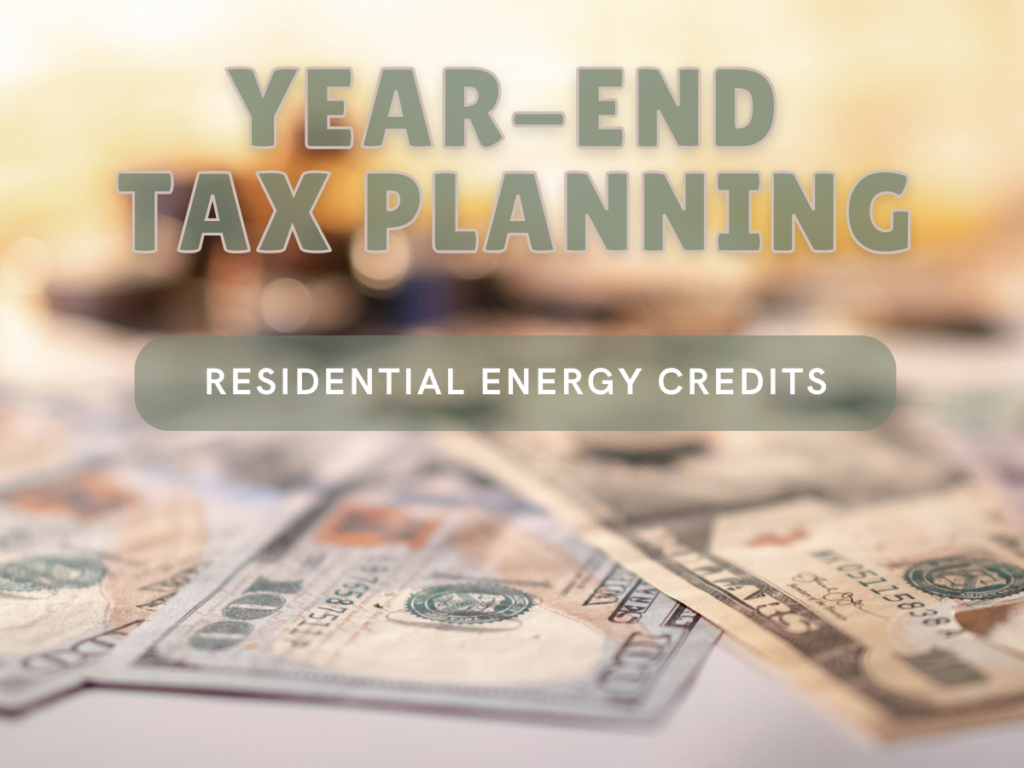As 2023 draws to a close, individual taxpayers can utilize a variety of tax planning strategies to help reduce taxable income. We will be posting a series of ideas to consider before year-end in order to minimize tax liability. See links under “Related Posts” for more tax-saving opportunities.
Residential Energy Credits
The passage of the Inflation Reduction Act of 2022 created opportunities for eligible taxpayers to receive a credit for qualified energy improvements made to their homes. Taxpayers can claim the Energy Efficient Home Improvement Credit and/or the Residential Clean Energy Property Credit for the year when the qualifying improvements are made.
The Energy Efficient Home Improvement Credit can be very useful for taxpayers considering an upgrade to various appliances or other components of their homes. Upon meeting compliance requirements, a taxpayer can receive a credit for the purchase of energy efficient windows, doors, central air-conditioning systems, water heaters, ovens and water pumps, to name a few of the qualifying items. The amount of credit that the taxpayer can receive is a percentage of the total qualified improvement expenses in the year of the installation.
Eligible expenses include qualified energy efficiency improvements installed during the year, residential energy property costs and home energy audits. In total, the maximum credit a taxpayer can receive in 2023 for energy property costs and certain energy efficient home improvements is the lesser of 30% of all qualified expenses, or $1,200, with limits on doors ($250 per door and $500 total), windows ($600) and home energy audits ($150). If the taxpayer buys a qualified heat pump, biomass stove or biomass boiler, then the credit is modified to the lesser of 30% of the qualified expenses, or $2,000. This credit has no lifetime dollar limit and can be claimed every year that eligible improvements are made until 2033.
Another credit that can be utilized by taxpayers considering improving their principal residence is the Residential Clean Energy Property Credit. If the criteria for qualified expenses are met, the taxpayer can receive a credit for improvements related to solar, wind or geothermal energy generation, solar water heaters, fuel cells, and battery storage systems. The credit is equal to 30% of the percentage of total improvement expenses in the year of installation. Unlike the Energy Efficient Home Improvement Credit, the Residential Energy Clean Property Credit does not have an annual limit. Because the qualifying improvement items can be costly, taxpayers can claim a substantial credit, which will significantly reduce their tax liability.
If a taxpayer is considering making improvements to upgrade a principal residence, it may be worth choosing something that qualifies as an energy improvement eligible for the one of the above-noted credits. Refer to the IRS-published overview and FAQ sheet for more details about these home energy credits.
If you need assistance with your year-end or overall tax-planning strategy, please contact the GYF Tax Services Group at 412-338-9300.
Related Posts:
Year-End Tax Planning Strategies for Individuals – Charitable Contributions
Year-End Tax Planning Strategies for Individuals – Tax-Loss Harvesting
Year-End Tax Planning Strategies for Individuals – Bunching of Itemized Deductions
Year-End Tax Planning Strategies for Individuals – Pre-tax and Self-employed Deductions
Year-End Tax Planning Strategies for Individuals – Securities








